 W
WBerol is a former British stationery manufacturing company, based in Lichfield. The company, established in 1845, manufactured a wide range of products including writing implements and art materials. In 1995 it was acquired by Sanford L.P., a division of Newell Brands, becoming a subsidiary of it until the last factory closed in 2010. Since then, Berol survived as a brand of imported products.
 W
WThe BIC Cristal is an inexpensive, disposable ballpoint pen mass-produced and sold by Société Bic of Clichy, Hauts-de-Seine, France. It was introduced in December 1950 and is the best-selling pen in the world, with the 100 billionth sold in September 2006. It has become the archetypal ballpoint pen and is considered ubiquitous, to the extent that the Museum of Modern Art has made it a permanent part of its collection. Its hexagonal form and design mimics a standard pencil and it is sold in six types of point and 18 colours around the world.
 W
WA chalkboard eraser is a special type of eraser specifically used to erase chalk markings on slating paint. It is most commonly made of felt strips attached to a handle. Chalkboard erasers are typically broad and rectangular, intended to clear large areas for new content as part of a lecture or presentation.
 W
WA connector pen is a type of felt-tip pen. They are available in 100 different shades and are sold in packs of 10, 12, 20, 24, 30, 36, 43, 50, 80 and 100. They are widely popular among children mainly because the pens can be joined together by their caps to make long chains or other constructions. There are also metallic colors and larger sized variants. The ink within Faber-Castell Connector Pens is non-toxic, safe for children, and washable from most clothing.
 W
WA copying pencil, also indelible pencil or chemical pencil, is pencil whose lead contains a dye. The lead is fabricated by adding a dry water-soluble permanent dye to powdered graphite—used in standard graphite pencils—before binding the mixture with clay.
 W
WA digital pen is an input device which captures the handwriting or brush strokes of a user and converts handwritten analog information created using "pen and paper" into digital data, enabling the data to be utilized in various applications. This type of pen is usually used in conjunction with a digital notebook, although the data can also be used for different applications or simply as a graphic.
 W
WA dip pen or nib pen or pen nib usually consists of a metal nib with capillary channels like those of fountain pen nibs, mounted in a handle or holder, often made of wood. Other materials can be used for the holder, including bone, metal and plastic; some pens are made entirely of glass.
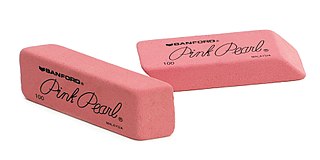 W
WAn eraser is an article of stationery that is used for removing marks from paper or skin. Erasers have a rubbery consistency and come in a variety of shapes, sizes and colors. Some pencils have an eraser on one end. Less expensive erasers are made from synthetic rubber and synthetic soy-based gum, but more expensive or specialized erasers are made from vinyl, plastic, or gum-like materials.
 W
WFaber-Castell is one of the world's largest and oldest manufacturers of pens, pencils, other office supplies and art supplies, as well as high-end writing instruments and luxury leather goods. Headquartered in Stein, Germany, it operates 14 factories and 20 sales units throughout the globe. The Faber-Castell Group employs a staff of approximately 7,000 and does business in more than 100 countries. The House of Faber-Castell is the family which founded and continues to exercise leadership within the corporation. They manufacture about 2 billion pencils in more than 120 different colors every year.
 W
WA ferrule is any of a number of types of objects, generally used for fastening, joining, sealing, or reinforcement. They are often narrow circular rings made from metal, or less commonly, plastic. Ferrules are also often referred to as eyelets or grommets within the manufacturing industry.
 W
WA fountain pen is a writing instrument which uses a metal nib to apply a water-based ink to paper. It is distinguished from earlier dip pens by using an internal reservoir to hold ink, eliminating the need to repeatedly dip the pen in an inkwell during use. The pen draws ink from the reservoir through a feed to the nib and deposits it on paper via a combination of gravity and capillary action. Filling the reservoir with ink may be achieved manually, via the use of an eyedropper or syringe, or via an internal filling mechanism which creates suction or a vacuum to transfer ink directly through the nib into the reservoir. Some pens employ removable reservoirs in the form of pre-filled ink cartridges.
 W
WFour Treasures of the Study, Four Jewels of the Study or Four Friends of the Study is an expression used to denote the brush, ink, paper and ink stone used in Chinese and other East Asian calligraphic traditions. The name appears to originate in the time of the Southern and Northern Dynasties.
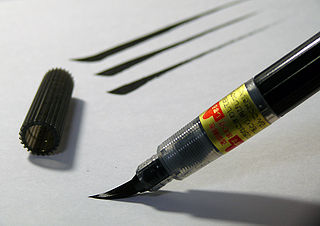 W
WThe fudepen (筆ペン), also known as "brush pen", is a cartridges-based writing implement used in East Asian calligraphy; in essence, an ink brush analogue to fountain pen.
 W
WA gel pen uses ink in which pigment is suspended in a water-based gel. Because the ink is thick and opaque, it shows up more clearly on slick surfaces than the typical inks used in ballpoint or felt tip pens. Gel pens can be used for many types of writing and illustration.
 W
WThe grease pencil, a wax writing tool also known as a wax pencil, china marker, or chinagraph pencil, is a writing implement made of hardened colored wax and is useful for marking on hard, glossy non-porous surfaces. This pencil is usually made from non-toxic opaque wax that is similar to a crayon but stronger. Marks made by grease pencils are resistant to moisture and can usually be removed by rubbing the marked surface with a paper towel.
 W
WA highlighter is a type of writing device used to mark attention to sections of text by marking them with a vivid, translucent colour. A typical highlighter is fluorescent yellow, coloured with pyranine. Different compounds, such as rhodamines are used for other colours.
 W
WInk brushes are paintbrushes used in Chinese calligraphy as well as in Japanese and Korean calligraphy which both have roots in Chinese calligraphy. They are also used in Chinese painting and other brush painting styles. The ink brush was invented in China around 300 B.C. Together with the inkstone, inkstick and Xuan paper, these four writing implements form the Four Treasures of the Study.
 W
WAn ink eraser is an instrument used to remove ink from a writing surface, which is more difficult than removing pencil markings. Older types are a metal scraper, which scrapes the ink off the surface, and an eraser similar to a rubber pencil eraser, but with additional abrasives, such as sand, incorporated. Fibreglass erasers also work by abrasion. These erasers physically remove the ink from the paper. There is some unavoidable damage with most types of paper and ink, where the paper absorbs some ink, but not all.
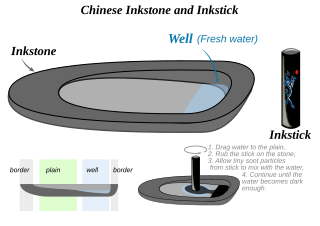 W
WAn inkstone is traditional Chinese stationery. It is a stone mortar for the grinding and containment of ink. In addition to stone, inkstones are also manufactured from clay, bronze, iron, and porcelain. The device evolved from a rubbing tool used for rubbing dyes dating around 6000 to 7000 years ago.
 W
WAn inkwell is a small jar or container, often made of glass, porcelain, silver, brass, or pewter, used for holding ink in a place convenient for the person who is writing. The artist or writer dips the brush, quill, or dip pen into the inkwell as needed or uses the inkwell as the source for filling the reservoir of a fountain pen. An inkwell usually has a lid to prevent contamination, evaporation, accidental spillage, and excessive exposure to air. A type known as the travelling inkwell was fitted with a secure, screw lid so a traveller could carry a supply of ink in their luggage without the risk of leakage.
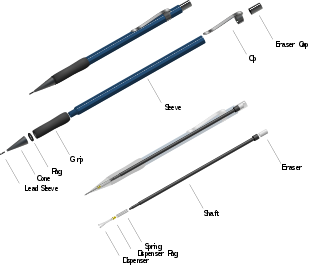 W
WA mechanical pencil, also clutch pencil, is a pencil with a replaceable and mechanically extendable solid pigment core called a "lead". The lead, often made of graphite, is not bonded to the outer casing, and can be mechanically extended as its point is worn away as it is being used. Other names include microtip pencil, automatic pencil, drafting pencil, technical pencil, click pencil, pump pen, pump pencil, leadholder, pacer, propelling pencil, pen pencil, and lead pencil.
 W
WNarayam or ezhuthani is a writing instrument (stylus) used since antiquity in South India, Sri Lanka and other proximate regions of Asia. Although similar to the modern day pen in shape and use, instead of using a colored ink, it scribes on the surface creating fine scratches in the form of letters and shapes. In essence, the narayam is a long piece of iron with a sharpened or pointed end and fabricated to ergonomically fit into the writer's fist.
 W
WThe Parker 51 is a fountain pen first introduced in 1941. Parker marketed it as “The World’s Most Wanted Pen,” a slogan alluding to restrictions on production of consumer goods for civilian markets in the United States during World War II. Parker's continual advertising during the war created demand that took several years to fulfil after the end of the conflict.
 W
WThe Parker Jotter is the Parker Pen Company's second and best-selling retracting refillable ballpoint pen. The first was the Hopalong Cassidy ballpoint.. Since 1954, over 750 million have been sold worldwide. It is priced between $6 for lower end models, and $20 for higher end models, such as special editions. Its refill has a ballpoint tip originally called the T-Ball, with a unique textured surface that greatly reduces slipping and failure to transfer ink onto slick paper, known as "skipping." The technology is now commonly used in the pen industry. The pens are also a popular advertising medium. The external design of the Parker T-Ball refill is a configuration copied by many other brands of refillable pens.
 W
WA pencil is a writing or drawing implement with a solid pigment core encased in a sleeve, barrel, or shaft that prevents breaking the core or marking a user's hand.
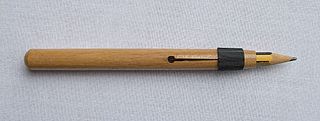 W
WA pencil extender is a small instrument allowing to extend small pencils, in order to facilitate their use.
 W
WA permanent marker or indelible marker is a type of marker pen that is used to create permanent or semi-permanent writing on an object. In general, the ink comprises a main carrier solvent, a glyceride, a pyrrolidone, a resin and a colorant, making it water resistant. It is capable of writing on a variety of surfaces from paper to metal to stone. They come in a variety of tip sizes, shapes, and colors. Like spray paint, these markers contain volatile organic compounds which evaporate to dry the ink. Due to compounds such as toluene and xylene often being present in permanent markers, they have a potential for abuse as a recreational drug.
 W
WPyrography or pyrogravure is the free handed art of decorating wood or other materials with burn marks resulting from the controlled application of a heated object such as a poker. It is also known as pokerwork or wood burning.
 W
WA quill is a writing tool made from a moulted flight feather of a large bird. Quills were used for writing with ink before the invention of the dip pen, the metal-nibbed pen, the fountain pen, and, eventually, the ballpoint pen.
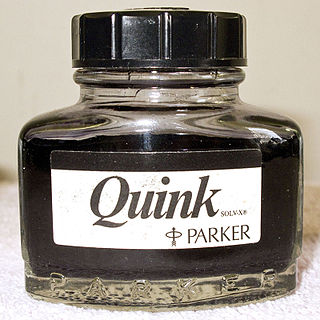 W
WQuink is a fountain pen ink developed by the Parker Pen Company. It was introduced in 1931 and has remained in production ever since.
 W
WA rastrum is a five-pointed writing implement used in music manuscripts to draw parallel staff lines when drawn horizontally across a blank piece of sheet music. The word "raster" is derived from the Latin for "rake". Rastra were used to draw lines on paper that had not been pre-ruled, and were widely used in Europe until printed staff paper became cheap and common in the nineteenth century. Some rastra are able to draw more than one staff at a time. Rastrology, the study of the use of the rastrum, is a branch of music manuscript studies that uses information about the rastrum to help find the date and provenance of musical materials.
 W
WA reed pen is a writing implement made by cutting and shaping a single reed straw or length of bamboo.
 W
WSidewalk chalk is typically large and thick sticks of chalk that come in multiple colors and are mostly used for drawing on pavement or concrete sidewalks, frequently four square courts or a hopscotch boards. Blackboard chalk, typically used in educational settings, is shorter and thinner than sidewalk chalk.
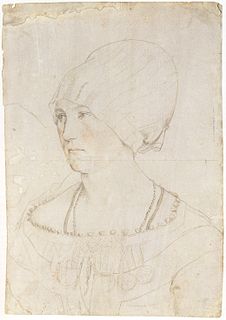 W
WSilverpoint is a traditional drawing technique first used by medieval scribes on manuscripts.
 W
WSkywriting is the process of using one or more small aircraft, able to expel special smoke during flight, to fly in certain patterns that create writing readable from the ground. These messages can be advertisements, general messages of celebration or goodwill, personal messages such as a marriage proposals and birthday wishes, or acts of protest.
 W
WSociété Bic S.A., commonly referred to simply as Bic and stylized as BiC, is a manufacturing corporation based in Clichy, France, best known for making disposable consumer products such as lighters, razors and pens. It was founded in 1945 by Marcel Bich.
 W
WA stylus is a writing utensil or a small tool for some other form of marking or shaping, for example, in pottery. It can also be a computer accessory that is used to assist in navigating or providing more precision when using touchscreens. It usually refers to a narrow elongated staff, similar to a modern ballpoint pen. Many styluses are heavily curved to be held more easily. Another widely used writing tool is the stylus used by blind users in conjunction with the slate for punching out the dots in Braille.
 W
WThe Syng inkstand is a silver inkstand used during the signing of the United States Declaration of Independence in 1776 and the United States Constitution in 1787. Besides paper documents, it is one of four still-existing objects that were present during the Constitutional Convention, along with the Liberty Bell, the chair that George Washington sat in as the Constitutional Convention's presiding officer, and Independence Hall itself.
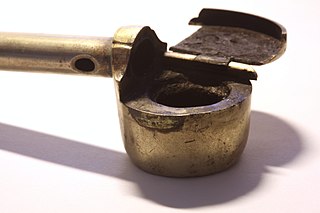 W
WYatate (矢立) are small personal smoking-pipe-shaped writing sets from medieval Japan which provided a carrying box for the ink cotton, and a shaft for a brush.
 W
WZebra Co., Ltd. is a Japanese manufacturer of writing instruments, established in 1914 by Tokumatsu Ishikawa.